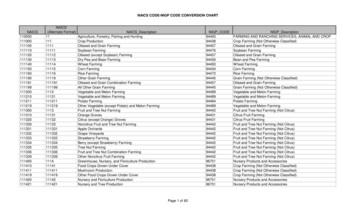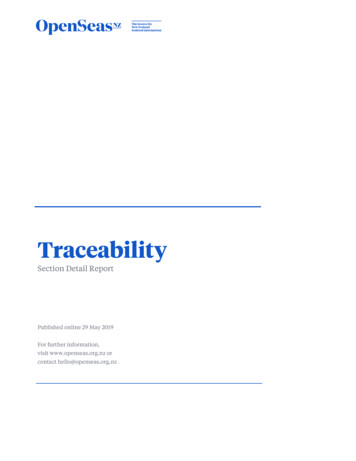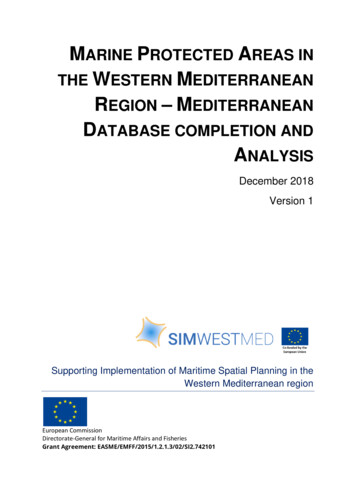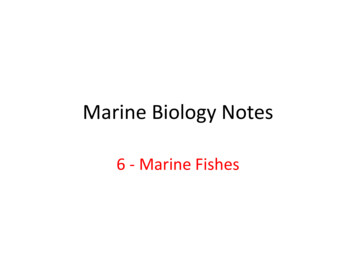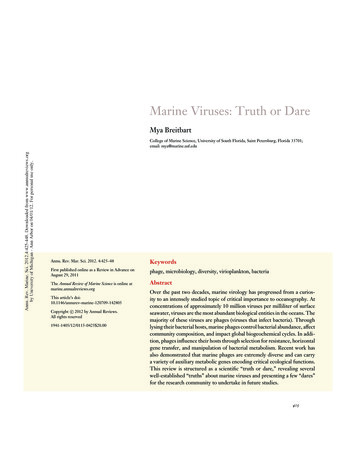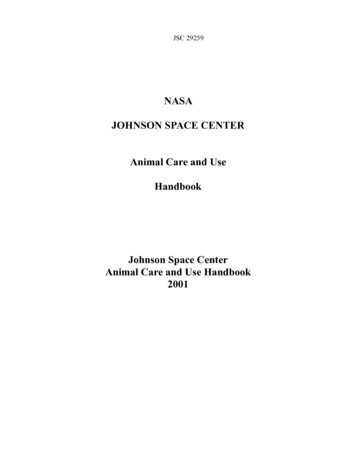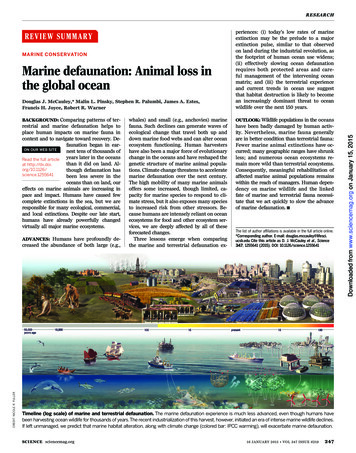
Transcription
R ES E A RC H MARINE CONSERVATIONMarine defaunation: Animal loss inthe global oceanDouglas J. McCauley,* Malin L. Pinsky, Stephen R. Palumbi, James A. Estes,Francis H. Joyce, Robert R. WarnerBACKGROUND: Comparing patterns of terrestrial and marine defaunation helps toplace human impacts on marine fauna incontext and to navigate toward recovery. Defaunation began in earON OUR WEB SITEnest tens of thousands ofyears later in the oceansRead the full articlethan it did on land. Alat http://dx.doi.org/10.1126/though defaunation hasscience.1255641been less severe in the.oceans than on land, oureffects on marine animals are increasing inpace and impact. Humans have caused fewcomplete extinctions in the sea, but we areresponsible for many ecological, commercial,and local extinctions. Despite our late start,humans have already powerfully changedvirtually all major marine ecosystems. CREDIT: NICOLE R. FULLERADVANCES: Humans have profoundly decreased the abundance of both large (e.g.,whales) and small (e.g., anchovies) marinefauna. Such declines can generate waves ofecological change that travel both up anddown marine food webs and can alter oceanecosystem functioning. Human harvestershave also been a major force of evolutionarychange in the oceans and have reshaped thegenetic structure of marine animal populations. Climate change threatens to acceleratemarine defaunation over the next century.The high mobility of many marine animalsoffers some increased, though limited, capacity for marine species to respond to climate stress, but it also exposes many speciesto increased risk from other stressors. Because humans are intensely reliant on oceanecosystems for food and other ecosystem services, we are deeply affected by all of theseforecasted changes.Three lessons emerge when comparingthe marine and terrestrial defaunation ex-periences: (i) today’s low rates of marineextinction may be the prelude to a majorextinction pulse, similar to that observedon land during the industrial revolution, asthe footprint of human ocean use widens;(ii) effectively slowing ocean defaunationrequires both protected areas and careful management of the intervening oceanmatrix; and (iii) the terrestrial experienceand current trends in ocean use suggestthat habitat destruction is likely to becomean increasingly dominant threat to oceanwildlife over the next 150 years.OUTLOOK: Wildlife populations in the oceanshave been badly damaged by human activity. Nevertheless, marine fauna generallyare in better condition than terrestrial fauna:Fewer marine animal extinctions have occurred; many geographic ranges have shrunkless; and numerous ocean ecosystems remain more wild than terrestrial ecosystems.Consequently, meaningful rehabilitation ofaffected marine animal populations remainswithin the reach of managers. Human dependency on marine wildlife and the linkedfate of marine and terrestrial fauna necessitate that we act quickly to slow the advanceof marine defaunation. The list of author affiliations is available in the full article online.*Corresponding author. E-mail: douglas.mccauley@lifesci.ucsb.edu Cite this article as D. J. McCauley et al., Science347, 1255641 (2015). DOI: 10.1126/science.1255641Timeline (log scale) of marine and terrestrial defaunation. The marine defaunation experience is much less advanced, even though humans havebeen harvesting ocean wildlife for thousands of years.The recent industrialization of this harvest, however, initiated an era of intense marine wildlife declines.If left unmanaged, we predict that marine habitat alteration, along with climate change (colored bar: IPCC warming), will exacerbate marine defaunation.SCIENCE sciencemag.org16 JANUARY 2015 VOL 347 ISSUE 6219247Downloaded from www.sciencemag.org on January 15, 2015REVIEW SUMMARY
R ES E A RC HREVIEW MARINE CONSERVATIONMarine defaunation: Animal loss inthe global oceanDouglas J. McCauley,1* Malin L. Pinsky,2 Stephen R. Palumbi,3 James A. Estes,4Francis H. Joyce,1 Robert R. Warner1Marine defaunation, or human-caused animal loss in the oceans, emerged forcefully onlyhundreds of years ago, whereas terrestrial defaunation has been occurring far longer.Though humans have caused few global marine extinctions, we have profoundly affectedmarine wildlife, altering the functioning and provisioning of services in every ocean.Current ocean trends, coupled with terrestrial defaunation lessons, suggest that marinedefaunation rates will rapidly intensify as human use of the oceans industrializes. Thoughprotected areas are a powerful tool to harness ocean productivity, especially when designedwith future climate in mind, additional management strategies will be required. Overall,habitat degradation is likely to intensify as a major driver of marine wildlife loss. Proactiveintervention can avert a marine defaunation disaster of the magnitude observed on land.Several decades of research on defaunationin terrestrial habitats have revealed a serialloss of mammals, birds, reptiles, and invertebrates that previously played importantecological roles (1). Here, we review themajor advancements that have been made inunderstanding the historical and contemporaryprocesses of similar defaunation in marine environments. We highlight patterns of similarityand difference between marine and terrestrialdefaunation profiles to identify better ways tounderstand, manage, and anticipate the effects offuture defaunation in our Anthropocene oceans.assemblages remain today more Pleistocene-like,at least with respect to species composition, thanterrestrial fauna. The delayed onset of intensiveglobal marine defaunation is most visible in acomparative chronology of faunal extinctions inwhich humans are likely to have directly or indirectly played a role (8) (Fig. 1).Comparing rates of animal extinctionDespite the recent acceleration of marine defaunation, rates of outright marine extinction havebeen relatively low. The International Union forConservation of Nature (IUCN) records only 15global extinctions of marine animal species inthe past 514 years (i.e., limit of IUCN temporalcoverage) and none in the past five decades (8, 9).By contrast, the IUCN recognizes 514 extinctionsof terrestrial animals during the same period(Fig. 1). While approximately six times more animal species have been cataloged on land than inthe oceans (10), this imbalance does not explainthe 36-fold difference between terrestrial andmarine animal extinctions.It is important to note that the status of only asmall fraction of described marine animal species have been evaluated by the IUCN, and manyassessed species were determined to be data deficient (11) (Fig. 2). This lack of information necessitates that officially reported numbers of extinctand endangered marine fauna be considered asminimum estimates (11). There remain, however,a number of data-independent explanations forthe lower extinction rates of marine fauna. Marine species, for instance, tend to be more widespread, exhibit less endemism, and have higherdispersal (12, 13).Complacency about the magnitude of contemporary marine extinctions is, however, ill-advised.If we disregard the 50,000-year head start ofintense terrestrial defaunation (Fig. 1) and compare only contemporary rates of extinction on landand in the sea, a cautionary lesson emerges. Marine extinction rates today look similar to themoderate levels of terrestrial extinction observedbefore the industrial revolution (fig. S1). Rates ofextinction on land increased dramatically after thisperiod, and we may now be sitting at the precipiceof a similar extinction transition in the oceans.Three other kinds of extinctionThe small number of species known to be permanently lost from the world’s oceans inadequatelyPatterns of marine defaunationDelayed defaunation in the oceansDefaunation on land began 10,000 to 100,000 yearsago as humans were expanding their range andcoming into first contact with novel faunalassemblages (2–4). By contrast, the physical properties of the marine environment limited ourcapacity early on to access and eliminate marineanimal species. This difficulty notwithstanding,humans began harvesting marine animals at least40,000 years ago, a development that some havesuggested was a defining feature in becoming“fully modern humans” (5). Even this early harvestaffected local marine fauna (6). However, globalrates of marine defaunation only intensified inthe last century with the advent of industrialfishing and the rapid expansion of coastal populations (7). As a result, extant global marine faunal1Department of Ecology, Evolution, and Marine Biology,University of California, Santa Barbara, CA 93106, USA.Department of Ecology, Evolution, and Natural Resources,Institute of Marine and Coastal Sciences, Rutgers University,New Brunswick, NJ 08901, USA. 3Department of Biology,Stanford University, Hopkins Marine Station, Pacific Grove,CA 93950, USA. 4Department of Ecology and EvolutionaryBiology, University of California, Santa Cruz, CA 95060, USA.2*Corresponding author. E-mail: douglas.mccauley@lifesci.ucsb.eduSCIENCE sciencemag.orgFig. 1. Comparative chronology of human-associatedterrestrial and marine animal extinctions. Green barsindicate animal extinctions that occurred on land, and bluebars indicate marine animal extinctions. Timeline measures years before 2014 CE. Only extinctions occurring less than 55,000 years ago are depicted.Defaunation has ancient origins on land but has intensified only within the last several hundred years in theoceans. See details in (8).16 JANUARY 2015 VOL 347 ISSUE 62191255641-1
R ES E A RC H R E V IE Wreflects the full impacts of marine defaunation.We recognize three additional types of defaunationinduced extinction.Local extinctionDefaunation has caused numerous geographicrange constrictions in marine animal species,driving them locally extinct in many habitats.These effects have been particularly severe amonglarge pelagic fishes, where 90% of studied species have exhibited range contractions (8, 14)(Fig. 3). Local extinctions, however, are not uniqueto large pelagic predators. Close to a third of themarine fishes and invertebrates off the NorthAmerican coasts that can be reliably sampled inscientific trawl surveys (often small to mediumbodied species) have also exhibited range contractions (Fig. 3). Such contractions can resultfrom the direct elimination of vulnerable subpopulations or from region-wide declines in abundance(14). Available data suggest that the magnitudeof the range contractions for this diverse set oftrawl-surveyed marine species is, on average,less than the contractions observed for terrestrialanimals such as mammals, birds, and butterflies.Though data deficiencies are abundant, most marine animal species also do not yet seem to exhibitsome of the most extreme range contractionsrecorded for terrestrial animals. Asian tigers, forexample, have lost 93% of their historical range(15), whereas tiger sharks still range across theworld’s oceans (16).Ecological extinctionReductions in the abundance of marine animalshave been well documented in the oceans (17).Aggregated population trend data suggest that inthe last four decades, marine vertebrates (fish,seabirds, sea turtles, and marine mammals) havedeclined in abundance by on average 22% (18).Marine fishes have declined in aggregate by38% (17), and certain baleen whales by 80 to 90%(19). Many of these declines have been termedecological extinctions—although the species inquestion are still extant, they are no longer sufficiently abundant to perform their functionalroles. Ecological extinctions are well known interrestrial environments and have been demonstrated to be just as disruptive as species extinctions (20). On land, we know of the phenomenonof “empty forests” where ecological extinctions offorest fauna alter tree recruitment, reshape plantdispersal, and cause population explosions ofsmall mammals (1, 20, 21). We are now observing the proliferation of “empty reefs,” “emptyestuaries,” and “empty bays” (7, 14, 22).gionally tenable (24). Likewise, the great whalesin Antarctica were serially hunted to commercial extinction (25).Not all species, however, are so “lucky” as tohave human harvesters desist when they becomeextremely rare. Demand and prices for certainhighly prized marine wildlife can continue to increase as these animals become less abundant—aphenomenon termed the anthropogenic Alleeeffect (26). Individual bluefin tuna can sell for US 100,000, rare sea cucumbers US 400/kg,and high-quality shark fins for US 100/kg. Suchspecies are the rhinos of the ocean—they maynever be too rare to be hunted.Differential vulnerability to defaunationAre certain marine animals more at risk thanothers to defaunation? There has been considerable attention given to harvester effects on largemarine animals (27). Selective declines of largebodied animals appear to be evident in certaincontexts (28, 29). As a result of such pressures,turtles, whales, sharks, and many large fishes arenow ecologically extinct in many ecosystems, andthe size spectra (abundance–body mass relationships) of many communities have changed considerably (7, 30, 31). Marine defaunation, however,has not caused many global extinctions of largebodied species. Most large-bodied marine animalspecies still exist somewhere in the ocean. Bycontrast, on land, we have observed the extinction of numerous large terrestrial species and aprofound restructuring of the size distribution ofland-animal species assemblages. The mean bodymass for the list of surviving terrestrial mammalspecies, for example, is significantly smaller thanthe body mass of terrestrial mammal species thatlived during the Pleistocene (1, 32). Such effects,however, are not evident for marine mammals (8)(fig. S2). Recent reviews have drawn attention tothe fact that humans can also intensely and effectively deplete populations of smaller marineanimals (29, 33). These observations have inspireda belated surge in interest in protecting smallforage fishes in the oceans.A review of modern marine extinctions and listings of species on the brink of extinction revealsfurther insight into aggregate patterns of differential defaunation risk in the oceans (Fig. 2). Seaturtles have the highest proportion of endangeredspecies among commonly recognized groupings ofmarine fauna. No modern sea turtle species, however, have yet gone extinct. Pinnipeds and marinemustelids, followed very closely by seabirds andshorebirds, have experienced the highest proportion of species extinctions. Many of the most threatened groups of marine animals are those thatdirectly interact with land (and land-based humans)during some portion of their life history (Fig. 2). Terrestrial contact may also explain why diadromous/brackish water fishes are more threatened thanexclusively marine fishes (Fig. 2).Although many marine animal species areclearly affected negatively by marine defaunation, there also appears to be a suite of defaunation “winners,” or species that are profiting inAnthropocene oceans. Many of these winners aresmaller and “weedier” (e.g., better colonizing andfaster reproducing) species. Marine invertebrates,in particular, have often been cited as examples ofCommercial extinctionSpecies that drop below an abundance level atwhich they can be economically harvested are extinct from a commercial standpoint. On land, commercial extinctions affected species ranging fromchinchilla to bison (23). Cases of commercial extinction are also common in the oceans. Gray whaleswere commercially hunted starting in the 1840s.By 1900, their numbers were so depleted thattargeted harvest of this species was no longer re1255641-216 JANUARY 2015 VOL 347 ISSUE 6219Fig. 2. Marine defaunation threat. Threat from defaunation is portrayed for different groups of marine faunaas chronicled by the IUCN Red List (113).Threat categories include “extinct” (orange), “endangered” (red; IUCNcategories “critically endangered” “endangered”), “data deficient” (light gray), and “unreviewed” (dark gray).Groups that contact land during some portion of their life history (green) are distinguished from species that donot (light blue).The total number of species estimated in each group is listed below the graph. Species groupingsare coded as follows: ST, sea turtles; PO, pinnipeds and marine mustelids; SS, seabirds and shorebirds; SSL, seasnakes and marine lizard; CS, cetaceans and sirenians; DBRF, diadromous/brackish ray-finned fishes; CF,cartilaginous fishes; MRF, exclusively marine ray-finned fishes; MI, marine invertebrates. See further details in (8).sciencemag.org SCIENCE
RE S EAR CH R E V I E Wspecies that are succeeding in the face of intensemarine defaunation: lobster proliferated as predatory groundfish declined (34), prawns increasedand replaced the dominance of finfish in landings (35), and urchin populations exploded in theabsence of their predators and competitors (36).Numerous mid-level predators also appear to benefit from the loss of top predators [e.g., small sharksand rays; (37)]—a phenomenon analogous to mesopredator release observed in terrestrial spheres(38). The status held by some of these defaunationwinners in the oceans may, however, be ephemeral.Many of the marine species that have initiallyflourished as a result of defaunation have themselves become targets for harvest by prey-switchinghumans as is evidenced by the recent global expansion of marine invertebrate fisheries (39).concern to defaunation. Coral reefs have beenexposed to a wide range of impacts and disturbances, including sedimentation and pollution,thermal stress, disease, destructive fishing, andcoastal development (44, 45). Such stressors negatively influence both corals and the millions ofspecies that live within and depend upon reefs(46). Risk, however, is not uniform, even across areefscape. Shallow backreef pools, for example,routinely overheat, and consequently, corals inthese parts of the reef are more resistant to oceanwarming (47). Environmentally heterogeneousareas may in fact act as important natural factories of adaptation that will buffer against sometypes of marine defaunation.Effects of marine defaunationSpatial patterns of vulnerabilityExtended consequences ofmarine defaunationPatterns of marine defaunation risk track differences in the physical environment. Global assessments of human impact on marine ecosystemssuggest that coastal wildlife habitats have beenmore influenced than deep-water or pelagic ecosystems (40). The vulnerability of coastal areas presumably results from ease of access to coastal zones.This relationship between access and defaunationrisk manifests itself also at smaller spatial scales,with populations of marine wildlife closest to tradenetworks and human settlements appearing oftento be more heavily defaunated (41, 42). The relativeinsulation that animal populations in regions likethe deep oceans presently experience, however,may be short-lived because depletions of shallowwater marine resources and the developmentof new technologies have created both the capacity and incentive to fish, mine, and drill oilin some of the deepest parts of the sea (28, 43).Coral reefs, in particular, have consistentlybeen highlighted as marine ecosystems of specialMarine defaunation has had far-reaching effectson ocean ecosystems. Depletions of a wide rangeof ecologically important marine fauna such ascod, sea otters, great whales, and sharks havetriggered cascading effects that propagate acrossmarine systems (37, 48–51). Operating in the opposite direction from trophic cascades are changesthat travel from the bottom to the top of foodchains as a result of the declining abundance oflower–trophic level organisms (52). Depletions offauna such as anchovies, sardines, and krill causereductions in food for higher-trophic level animalssuch as seabirds and marine mammals, potentially resulting in losses in reproduction or reductions in their population size (33, 53).The extended effects of defaunation on marineecosystems also occur beyond the bounds of thesetop-down or bottom-up effects. Defaunation canreduce cross-system connectivity (54, 55), decreaseecosystem stability (56), and alter patterns of biogeochemical cycling (57). The ill effects of foodFig. 3. Comparisons of range contractions for select marine and terrestrial fauna. Terrestrial (green)and marine cases (blue) include evaluations of geographical range change for: 43 North Americanmammals over the last 200 years (NM) (114), 18 Indian mammals over the last 30 years (IM) (115), 201British birds from 1970 to 1997 (BB) and 58 British butterflies from 1976 to 1997 (BF) (116), 12 globallarge pelagic fishes from the 1960s to 2000s (PF) (14), and 327 trawl-surveyed North American marinefish and invertebrates from the 1970s to 2000s (TFI). (A) Percent of species whose ranges havecontracted with binomial confidence intervals and (B) distribution of percent contraction for those speciesthat have contracted (violin plot). Sample sizes are shown above each data point, white horizontal lines (B)show the medians, and thick vertical black lines display the interquartile range. See details in (8).SCIENCE sciencemag.orgweb disarticulation can be further amplified whenthey occur in association with other marine disturbances. For example, mass releases of discarded plant fertilizers into marine ecosystemsfrom which defaunation has eliminated importantconsumers can create “productivity explosions” byfueling overgrowth of microbes and algae thatfail to be routed into food webs (58, 59).The selective force of human predation hasalso been sufficiently strong and protracted soas to have altered the evolutionary trajectory ofnumerous species of harvested marine fauna(60). Harvest has driven many marine animalspecies to become smaller and thinner, to growmore slowly, to be less fecund, and to reproduceat smaller sizes (61). There is also evidence thatharvest can reduce the genetic diversity of manymarine animal populations (62). The genetic effects of defaunation represent a loss of adaptivepotential that may impair the resilient capacityof ocean wildlife (63).Importance of marine defaunationto humansMarine defaunation is already affecting humanwell-being in numerous ways by imperiling foodsustainability, increasing social conflict, impairing storm protection, and reducing flows of otherecosystem services (64, 65). The most conspicuous service that marine fauna make to society isthe contribution of their own bodies to globaldiets. Marine animals, primarily fishes, make upa large proportion of global protein intake, andthis contribution is especially strong for impoverished coastal nations (66). According to theU.N. Food and Agriculture Organization (FAO),40 times more wild animal biomass is harvestedfrom the oceans than from land (67). Declines inthis source of free-range marine food represent amajor source of concern (65).A diverse array of nonconsumptive servicesare also conferred to humanity from ocean animals, ranging from carbon storage that is facilitated by whales and sea otters to regional cloudformation that appears to be stimulated by coralemissions of dimethylsulphoniopropionate (DMSP)(57, 68, 69). Another key service, given forecastsof increasingly intense weather events and sealevel rise, is coastal protection. Coral, oyster, andother living reefs can dissipate up to 97% of thewave energy reaching them, thus protecting builtstructures and human lives (70). In some cases,corals are more than just perimeter buffers; theyalso serve as the living platform upon which entire countries (e.g., the Maldives, Kiribati, theMarshall Islands) and entire cultures have beenfounded. Atoll-living human populations in theseareas depend on the long-term health of theseanimate pedestals to literally hold their livestogether.Outlook and ways forwardWill climate change exacerbatemarine defaunation?The implications of climate change upon marinedefaunation are shaped by ocean physics. Marinespecies live in a vast, globally connected fluid16 JANUARY 2015 VOL 347 ISSUE 62191255641-3
R ES E A RC H R E V IE Wmedium that has immense heat-storage capacityand has exhibited a historically robust capabilityto buffer temperature change over daily, annual,and even decadal time scales (71). While this buffering capacity at first seems to confer an advantage to marine fauna, the thermal stability of theoceans may have left many subtidal marine animals poorly prepared, relative to terrestrial counterparts, for the temperature increases associatedwith global warming. The same logic supportsrelated predictions that terrestrial fauna living inmore thermally stable environments will be morevulnerable to warming than those found in areasof greater temperature variability (72).Ocean warming presents obvious challengesto polar marine fauna trapped in thermal deadends (73). Tropical marine species are, however,also highly sensitive to small increases in temperature. For example, coastal crabs on tropicalshores live closer to their upper thermal maximathan do similar temperate species (74). Likewise,the symbiosis of corals and dinoflagellates isfamously sensitive to rapid increases of only 1 to2 C (75). Even though corals exhibit the capacityfor adaptation (47), coral bleaching events areexpected to be more common and consequentlymore stressful by the end of the century (76). Theeffects of rising ocean temperature extend wellbeyond coral reefs and are predicted to affectboth the adult and juvenile stages of a diverse setof marine species (77), to reshuffle marine community composition (78), and to potentially alterthe overall structure and dynamics of entire marine faunal communities (79).The wide range of other climate changeassociated alterations in seawater chemistryand physics—including ocean acidification, anoxia,ocean circulation shifts, changes in stratification,and changes in primary productivity—will fundamentally influence marine fauna. Ocean acidification, for example, makes marine animalshell building more physiologically costly, candiminish animal sensory abilities, and can altergrowth trajectories (80, 81). Climate change impacts on phytoplankton can further accentuatedefaunation risk (82). At the same time thathumans are reducing the abundance of marineforage fish through direct harvest, we also maybe indirectly reducing the planktonic food forforage fish and related consumers in manyregions.Mobility and managing defaunationMany marine animals, on average, have significantly larger home ranges as adults [Fig. 4 andfigs. S3 and S4; (8)] and disperse greater distances as juveniles than their terrestrial counterparts (13). This wide-ranging behavior of manymarine species complicates the management ofocean wildlife as species often traverse multiplemanagement jurisdictions (83–85). On the otherhand, the greater mobility of many marine animal species may help them to better follow thevelocity of climate change and to colonize andrecolonize habitats, so long as source populationrefuges are kept available (71, 73, 78, 86, 87).Marine protected areas can offer this sort ofrefuge for animal populations (88). The establishment of protected areas in the oceans lags farbehind advancements made on land, with anupper-bound estimate of only about 3.6% of theworld’s oceans now protected (8) (fig. S5). Onesource of optimism for slowing marine defaunation, particularly for mobile species, is that themean size of marine protected areas has increased greatly in recent years (fig. S5). However,most marine protected areas remain smaller (median 4.5 km2) than the home range size of manymarine animals (Fig. 4). Though much is lost inthis type of crude comparison, this observationhighlights what may be an important disconnect between the scales at which wildlife usethe oceans and the scale at which we typicallymanage the oceans.Fig. 4. Mobility of terrestrial and marinefauna. Because mobility shapes defaunationrisk, we compare thesize-standardizedhome range size of arepresentative selection of marine (blue)and terrestrial (green)vertebrates. Data arepresented for adultsover a full range ofanimal body sizes,plotted on a logarithmic scale. Speciesinclude seabirds,marine reptiles, marinefishes, marine mammals, terrestrial birds,terrestrial reptiles, andterrestrial mammals (see details in (8); table S2 and fig. S3). Regression lines enclosed by shadedconfidence intervals are plotted for all marine and all terrestrial species. The dotted red line demarcatesthe current median size of all marine protected areas (MPAs).1255641-416 JANUARY 2015 VOL 347 ISSUE 6219This spatial mismatch is just one of manyreasons why protected areas cannot be the fullsolution for managing defaunation (83). Welearned this lesson arguably too late on land.Protected areas can legitimately be viewed assome of our proudest conservation achievementson land (e.g., Yosemite, Serengeti, Chitwan National Parks), and yet with four times more terrestrial area protected than marine protected area,we have still failed to satisfactorily rein in terrestrial defaunation (1) (fig. S5). The realizationthat more was needed to curb terrestrial defaunation inspired a wave of effort to do conservation out of the bounds of terrestrial protectedareas (e.g., conservation easements and corridorprojects). The delayed implementation of thesestrategies has, however, often relegated terrestrial conservation to operating more as a retroactive enterprise aimed at restoring damaged habitatsand triaging wildlife losses already underway. Inthe oceans, we are uniquely positioned to preemptively manage defaunation. We can learnfrom the terrestrial defaunation experience thatprotected areas are valuable tools, but that wemust proactively introduce measures to manageour impacts on marine fauna in the vast majorityof the global oceans that is unprotected.Strateg
Marine defaunation, or human-caused animal loss in the oceans, emerged forcefully only hundreds of years ago, whereas terrestrial defaunation has been occurring far longer. Though humans have caused few global marine extinctions, we have profoundly affected marine wildlife, altering the
